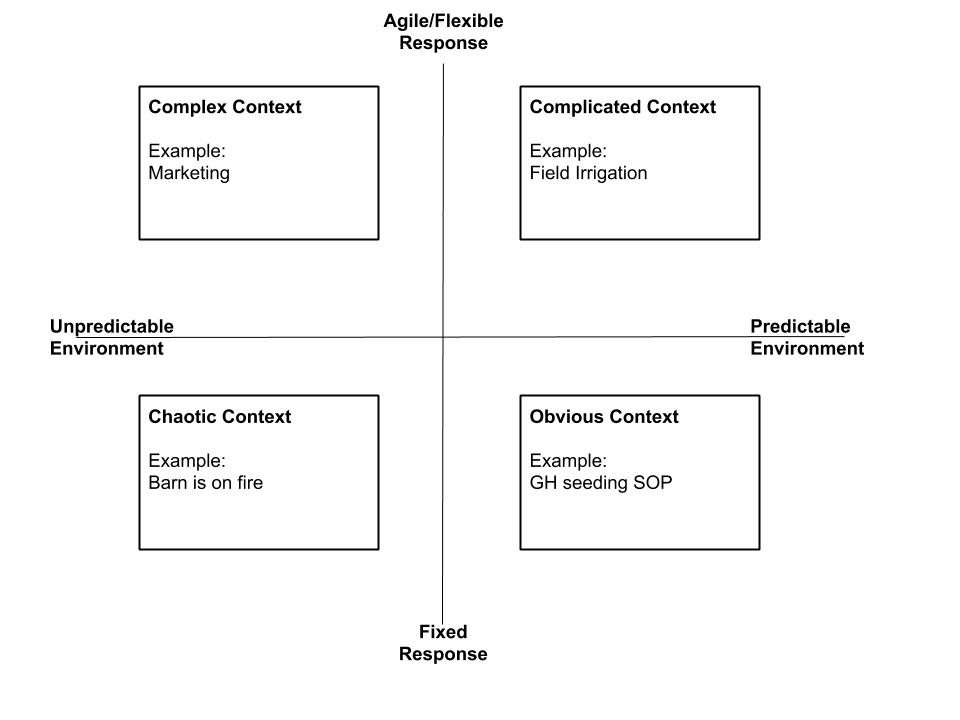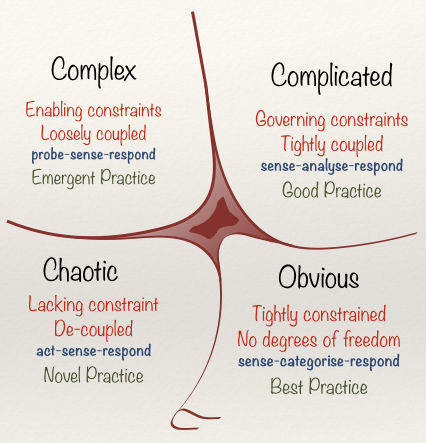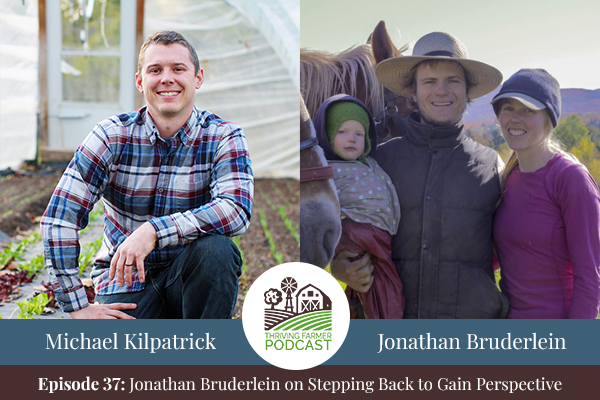“To she who holds a hammer, every problem looks like a nail”
Have you noticed that your personal leadership style affects the way in which you frame problems and seek to solve them?
Enter the Cynefin framework!! By creating a clear lens through which we can see challenges on the farm, the Cynefin framework is a powerful tool to make sure that we are using our energy optimally by applying the appropriate response to each problem.
The framework is composed of a horizontal axis and a vertical axis.
The horizontal axis describes the nature of the environment the problem is in: Predictable vs. Unpredictable. The predictable domain is to the right; this represents an environment where there is a high degree of cause and effect. To the left lies the unpredictable; the rules of cause and effect do not apply here.
The vertical axis describes the nature of the response to the problem: Agile/flexible vs Fixed. Up top, we have the agile/flexible contexts; where the response to a problem is always different. Down below, we have the domain of fixed responses; where given problems always have the same solution.
Put this together and you get the following 4 quadrants.

Here is the original Cynefin diagram where for whatever reason, they don’t explicitly name the horizontal and vertical axis. The dark area in the center represents the state of disorder. Disorder is the state of not knowing what kind of context you are in.

Let’s take a look at how each of these contexts shows up on your farm and what leadership style is most appropriate in each context. The discernment to accurately know what kind of context we are in is crucial and is the defining criteria to move from disorder to order (yes, even chaos is a form of an ordered system).
Obvious
This is the context when there is a cause and effect relationship in the environment (predictable environment) and where it is possible to know the best solution that will always apply to this problem (fixed response).
Examples of this in the farm setting would be:
- How we seed a tray of seedlings;
- How we wash and pack kale;
- In what condition we leave the wash station when we’re done. (clean)
There’s basically one best way to do it… my way!! (just kidding). While we can recognize that we can always incrementally improve these processes, the fact is that we can determine the best practice for how we do this on our farm. It’s a total waste of time and energy to reinvent the wheel each time. This is the appropriate context to create and use SOPs (Standard Operating Procedure) and checklists.
Complicated
This is the context where there is a high cause and effect relationship in the environment (predictable environment) and where we need to adapt our response based on the specificity of the problem (agile/flexible response).
Complicated problems show up a lot on the farm. In this context, there is a right answer but we first need to clarify the parameters of the problem. Examples of complicated contexts on the farm are:
- Tillage and bed prep;
- Irrigation;
- Weed control;
- Greenhouse management;
- Watering seedlings in the GH.
The key point to retain here is that we know how to do these things well, but we need to be flexible in our response (be agile) based on environmental conditions. For example, we know how to control weeds, but our tactics will vary based on time of year, weed pressure, crop type, weed type, equipment, soil type, etc.
Complex
This is the context where there is a low or non-existent cause and effect relationship in the environment (unpredictable environment) and where we need to adapt our response based on the specificity of the problem (agile/flexible response).
Whereas in the Complicated context we know there is a right answer available once we clarify the parameters, this is not the case in a complex problem. The complex context is the domain of probing for emergent solutions, which usually brings up further questions given that the act of finding an emerging solution modifies the nature of the problem and requires us to attune ourselves to the new.
Examples of complex problems on the farm are:
- Marketing and Sales;
- Employee management:
- Research and development.
These are areas where we can’t be sure what impact our actions will have. The key here is to remember that the order of operations is: Probe-Sense-Respond. It is essential to keep an open mind and to remember that the goal in the complex domain is not to find the final solution; It is to be able to continue to pursue and respond to the ever-emerging and evolving solution.
Chaotic
Last but not least is the chaotic context. This is actually the favorite paradigm for quite a few of us farmers. We just love the adrenaline rush of having to solve urgent problems on the fly!! But… let’s just say that is ain’t quite the most effective manner of constructing a profitable business that sustains us both economically and emotionally.
The chaotic context is a context where there is a low or non-existent cause and effect relationship in the environment (unpredictable environment) but where the situation is so urgent (and consequent) that you have no time for an agile/flexible response… you just need to act NOW with a fixed response (usually an action that seems quite evident in the moment).
If the barn is burning, there’s no time to sense or probe… you just have to act! Get people out! Try to contain the fire! Etc. When your caterpillar tunnel is about to blow away in the wind you just have to act NOW to try and avert disaster (weight it down, extra anchors, try and get it off in a controlled manner, etc).
Your turn:
The bottom line is to realize that at any one moment there are multiple contexts at play in different areas of the farm… and that you have a default problem-solving mode that may be tainting the way you can conceive of solutions. We need to be aware of our bias and be intentional in the way we seek to solve problems on the farm.
- Which of these 4 contexts are you most comfortable in?
- What is your default problem-solving mode (AKA leadership style)?
- Which context is the most present on your farm?
- Which challenges have you been trying to apply the wrong context to? (for example, treating a problem in the Obvious context as if it’s Complex rather than simply writing a Standard Operating Procedure (Farm SOP))
Let me know what you think of all this. I know that it’s a little heady, but once you wrap your head around it, it’s actually a powerful tool seeing current challenges from a different angle.
Here’s a short video with Cynefin’s inventor, Dave Snowden, that goes a little deeper into the subject.
If you want to chat about this and how it applies to your case, don’t hesitate to book a free discovery session with me. www.calendly.com/farmercoach/55min
Enjoy!!


